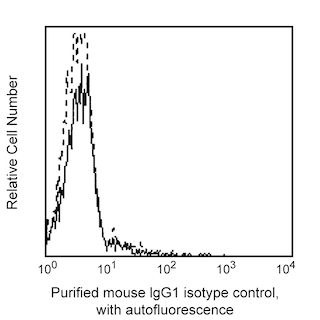Old Browser
This page has been recently translated and is available in French now.
Looks like you're visiting us from {countryName}.
Would you like to stay on the current country site or be switched to your country?




Profile of peripheral blood lymphocytes analyzed on a FACScan (BDIS, San Jose, CA)


BD Pharmingen™ Purified Mouse Anti-Human CD23

Regulatory Status Legend
Any use of products other than the permitted use without the express written authorization of Becton, Dickinson and Company is strictly prohibited.
Preparation And Storage
Recommended Assay Procedures
The biotinylated M-L233 antibody is useful as a detector antibody in ELISA for measuring soluble CD23 (sCD23) protein levels in combination with clone M-L234 as the capture antibody. This antibody has been reported for Western Blot application.
Product Notices
- Since applications vary, each investigator should titrate the reagent to obtain optimal results.
- Please refer to www.bdbiosciences.com/us/s/resources for technical protocols.
- Caution: Sodium azide yields highly toxic hydrazoic acid under acidic conditions. Dilute azide compounds in running water before discarding to avoid accumulation of potentially explosive deposits in plumbing.
Companion Products

.png?imwidth=320)
The M-L233 antibody specifically binds to human CD23, the low affinity receptor for human IgE (FcεRII). CD23 is a type II membrane glycoprotein that is expressed by B cells, monocytes, macrophages, eosinophils, platelets and dendritic cells. CD23 mediates IgE-dependent cytotoxicity and phagocytosis by macrophages and eosinophils. Soluble CD23 (sCD23) can be released by CD23-positive cells as a result of proteolytic cleavage of membrane CD23. Larger fragments of sCD23 (e.g., 25-37 kDa) retain their IgE-binding capacity whereas smaller fragments (ie, ≤ 12 kDa) do not. Soluble CD23 may have immunoregulatory effects on the growth and differentiation of B cells and other cell types.
Development References (6)
-
Barclay NA, Brown MH, Birkeland ML, et al, ed. The Leukocyte Antigen FactsBook. San Diego, CA: Academic Press; 1997.
-
Belleau JT, Gandhi RK, McPherson HM, Lew DB. Research upregulation of CD23 (FcepsilonRII) expression in human airway smooth muscle cells (huASMC) in response to IL-4, GM-CSF, and IL-4/GM-CSF. Clin Mol Allergy. 2005; 3(6):1-12. (Clone-specific). View Reference
-
Delespesse G, Hofstetter H, Sarfati M. Low-affinity receptor for IgE (FcERII, CD23) and its soluble fragments. Int Arch Allergy Immunol. 1989; 90(1):41-44. (Biology). View Reference
-
Gordon J, Millsum MJ, Flores-Romo L, Gillis S. Regulation of resting and cycling human B lymphocytes via surface IgM and the accessory molecules interleukin-4, CD23 and CD40. Immunology. 1989; 68(4):526-531. (Biology). View Reference
-
Saeland S, Duvert V, Moreau I, Banchereau J. Human B cell precursors proliferate and express CD23 after CD40 ligation. J Exp Med. 1993; 178(1):113-120. (Biology). View Reference
-
Schlossman SF. Stuart F. Schlossman .. et al., ed. Leucocyte typing V : white cell differentiation antigens : proceedings of the fifth international workshop and conference held in Boston, USA, 3-7 November, 1993. Oxford: Oxford University Press; 1995.
Please refer to Support Documents for Quality Certificates
Global - Refer to manufacturer's instructions for use and related User Manuals and Technical data sheets before using this products as described
Comparisons, where applicable, are made against older BD Technology, manual methods or are general performance claims. Comparisons are not made against non-BD technologies, unless otherwise noted.
For Research Use Only. Not for use in diagnostic or therapeutic procedures.
Report a Site Issue
This form is intended to help us improve our website experience. For other support, please visit our Contact Us page.